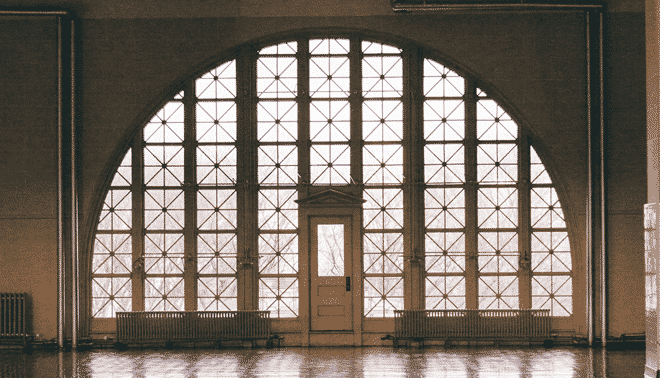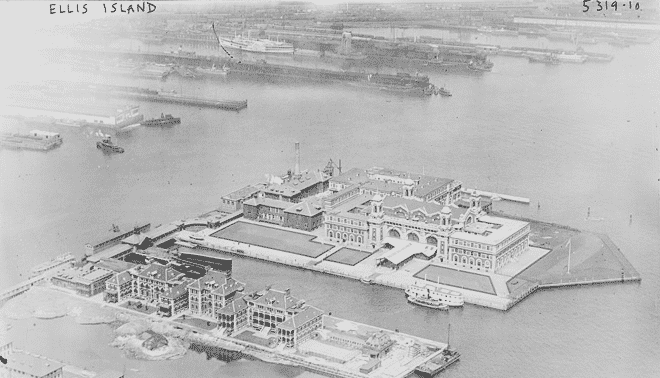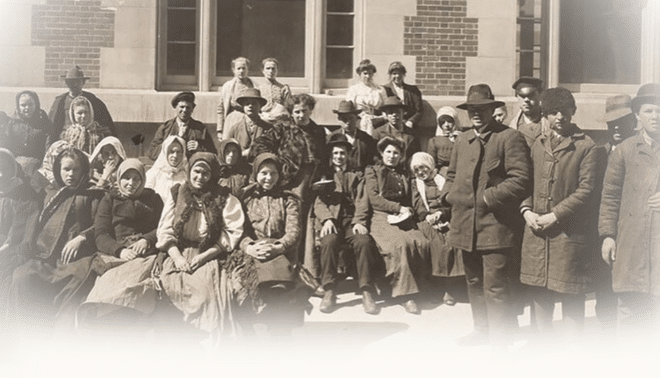Sign up for the Family Tree Newsletter Plus, you’ll receive our 10 Essential Genealogy Research Forms PDF as a special thank you!
Get Your Free Genealogy Forms
"*" indicates required fields

Your visit to Ellis Island will be a good deal more comfortable than your immigrant ancestors’ was, but you can still get a feel for what they went through. Today, Ellis Island is a popular, attractive, high-tech tourist attraction, run by the National Park Service of the US Department of the Interior.
Ready to walk in your immigrant ancestor’s footsteps?
Ferries to Ellis Island
Admission to the museum on Ellis Island is free, but you will need to purchase ferry tickets. The only ferry company authorized by the National Park Service is Statue Cruises—avoid street sellers! You can purchase ferry tickets on their website or by calling 1-877-LADY-TIX. One ticket takes visitors to both the Statue of Liberty and Ellis Island and includes the audio tour, which can be picked up at the Acoustiguide booth on both islands.
Ferries depart from Battery Park in Manhattan and Liberty State Park in New Jersey and depart from 8:30 a.m. to 5:00 p.m. approximately every 20-35 minutes. (If you want to include a climb to the Statue of Liberty’s crown in your trip, be sure to catch the first ferry of the day!)
Hard Hat Tour Option
This ferry ticket option (ages 13 and up only) includes a 90 minute guided tour led by Save Ellis Island experts and educators. On the tour, visitors will have access to the unrestored Ellis Island immigrant hospital buildings including:
- Laundry Building
- Power House
- wards
- kitchen
- autopsy theater residence
Also included on the tour is the art exhibit “Unframed – Ellis Island,” by renowned French artist JR. The artwork is on display throughout the hospital complex with installations on 16 interior walls.
A portion of the ticket price goes toward the restoration and maintenance of the historic Ellis Island Immigrant Hospital.
The Ellis Island National Museum of Immigration

The former main building of the immigration facility has been transformed into the Ellis Island Immigration Museum. It features more than 30 galleries of artifacts and historic images, covering 200,000 square feet. Two theaters feature the award-winning “Island of Hope, Island of Tears,” a free half-hour movie documentary. The museum also includes a bookstore, gift shop and cafeteria.
The free included audio tours contains more than 120 hours of contents and 2,000 audio stop segments. Listeners can experience the entire museum through its three parts: “The Ellis Experience,” “Journeys: The Peopling of America,” and “Journeys: New Eras of Immigration.” The tour comes in 12 languages, American Sign Language (ASL), and Audio Descriptive (AD). A family-friendly tour is also offered.
American Family Immigration History Center
This center allows visitors to explore and research the Port of New York Passenger Records 1820-1957. Alternatively, you can search the archives online. The Statue of Liberty–Ellis Island Foundation website also includes some great genealogy tips, as well as some fun “ancestor hunt” activities for all ages.
Records available to search include:
- Original Manifests
- Passenger Records
- Ship Information
Your searches and record images can be saved online in Your Profile, which you can open by registering at the museum or on its website. Document copies can be purchased online or at the Family History Center on Ellis Island. Registration is free but membership expands the amount of documents you can keep in Your Profile.
Members of The Statue of Liberty-Ellis Island Foundation have created a Community Archive of annotations for archive visitors, which provide new information on a passenger’s background and life in the United States.
Peopling of America Center
An expansion of the museum, the Peopling of American Center opened in 2015. These galleries bookend the Ellis Island era by telling the story of immigration to America before the station opened in 1892 and after it closed in 1954. These exhibits examine how immigrants began their journey to America ,and the efforts they took to assimilate to their new nation once they arrived.

The entrance is the former Baggage Room, which now holds the World Migration Globe, “a radiant globe which illustrates migration patterns throughout human history not only to the United States but around the world.” Also located here is an interactive video installation titled American Flag of Faces, which features images of families and ancestors submitted from individuals around the globe. An ongoing, “living” exhibit, the American Flag of Faces continually accepts photo submissions.
The American Immigrant Wall of Honor
The American Immigrant Wall of Honor at Ellis Island, the largest wall of names in the world, honors all who came and built America. Whether your immigrant ancestors entered through Ellis Island, through another port, or forcibly as slaves, you can memorialize them on the Wall of Honor.
The wall is one of the chief fund-raisers for the Statue of Liberty-Ellis Island Foundation. A minimum contribution of $150 is required to place a name on the wall. Computer kiosks in the Ellis Island museum allows visitors to search for names, as well as for donors. You can also search for Wall of Honor names here.
Diane Haddad and David Fryxell contributed to this article.
Portions of this article appeared in the January 2000 issue of Family Tree Magazine.
Related Reads
ADVERTISEMENT




